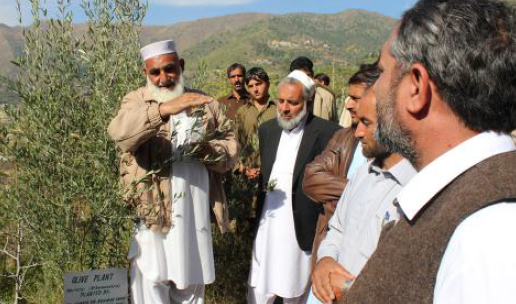Participatory Vulnerability Assessments as a basis for EbA planning
Ecological Drawing to map the village
Shaun Martin
This stage of the process aims at assessing information on conventional (non-climatic) vulnerabilities of people and ecosystems. Surveys in four villages in Kyrgyzstan’s Naryn province and Tajikistan’s West-Pamiri Bartang Valley addressed the following issues:
• Ecosystem services used by the local population and their spatial and temporal distribution
• Availability of ecosystem services, ecosystem health and function, and perceived changes
• Vulnerability of livelihoods and the link to the status and availability of ecosystem services
• Perception of climate change and its effects on the availability of ecosystem services
• Assessment of legal / institutional / administrative/ technical and information deficits relevant for EbA in the area
The field work started with village workshops to introduce the project, identify key stakeholders as well as interests and needs of village residents. Information was collected by means of interview with residents and key informants, group discussions, field surveys (village walks, mapping, sampling) and participatory resource mapping. To assess overall vulnerability, the availability of ecosystem services and their contribution to local livelihoods is comparatively ranked.
• Detailed scoping (Step 1) before the assessment: choosing the community, (pre)identifying livelihood strategies, ecosystem services and the respective ecosystems
• Participatory approach involving villagers and key informants
• Conducting village workshops in a simple language (beyond project terminology)
• A stand-alone VA conducted by external experts should be avoided. Most of the information necessary for further planning cannot be retrieved from reports only.
• The developed EbA method comprises a full-fledged vulnerability assessment: Step 1-4 (scoping and identification of conventional threats), Step 5 (climate perspective), Step 6 (threat prioritization) and Step 7 (summarize situation).
• Identifying vulnerabilities of people is rather straightforward. However, identifying the vulnerabilities of relevant ecosystems and making sure that nature itself is able to adapt poses a challenge due to lack of data and time constraints.
• Social disparities make climate vulnerability a socially driven vulnerability of livelihood. An unequal access to water will increase the social vulnerability of livelihood. An EbA strategy will have to address a socially compensating access to the resource.
• Scoping: an extension of the project zone in order to cover the complete life cycle (e.g. summer pasture) of the target population is important.
